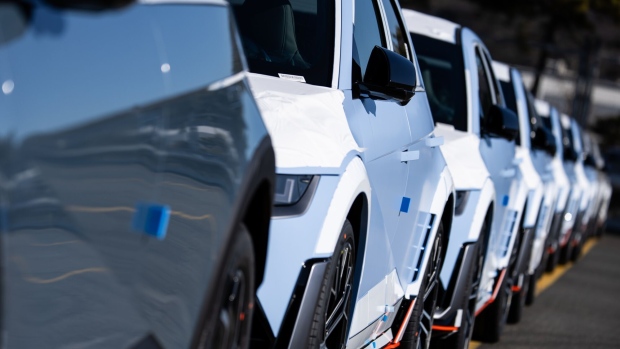Jun 26, 2024
Hyundai Seeks More EV Converts with Sub-€25,000 Inster City Car
, Bloomberg News

(Bloomberg) -- Hyundai Motor Co. is joining the ranks of automakers trying to hasten electric car adoption and fend off low-cost competition from China with a battery-powered model it says will cost less than 25,000 euros ($26,775).
The Inster subcompact SUV, which debuted at the Busan International Mobility Show on Thursday, will go on sale in South Korea this summer before being exported to Europe, the Middle East and later the Asia Pacific region, the company said.
The 3.8 meter-long city car, known as the Casper electric in Korea, comes with standard driver-assistance software and a 42 kilowatt-hour nickel-based battery that can go 300 kilometers (186 miles) on a single charge; a larger battery pack offers 355-kilometer range. Exact pricing will be released later this year.
“Legacy automakers are starting to release smaller EVs to push electrification in the mass market, as they expect the demand for that segment would grow,” said Kim Sung-rae, an analyst at Hanwha Investment & Securities in Seoul. Car buyers in South Korea and Southeast Asia “have been reluctant to have EVs due to their high prices and big size,” he said.
Global automakers from Hyundai to Tesla Inc. to Ford Motor Co. are developing more affordable EVs as higher interest rates squeeze consumers and Chinese upstarts ramp up exports of low-cost cars with cutting edge technology. BYD Co. is planning to bring its electric Seagull hatchback, which sells for less than $10,000 in China, to Europe next year. Even after tariffs and modifications to meet European standards, BYD executives expect the Seagull to sell for less than €20,000 on the continent.
“Our target has always been to produce a car for our audience in Europe below 25,000 euros,” Andreas-Christoph Hoffman, Hyundai’s vice-president of marketing and product in Europe, said in a statement.
Hyundai sold more than 635,000 vehicles in Europe last year, its third-biggest region after the US and Korea. While growth in Europe and the US fueled record profits for the Korean automaker, declines in China accelerated. The world’s third-largest carmaking group now commands less than 1% of the Chinese market, down from about 10% during its heyday in 2009.
While China and the European Union wrangle over tariffs on China-made EVs, France’s Renault SA and Stellantis NV are cutting deals with Chinese rivals to help confront the onslaught of cheaper exports to Europe. Renault will develop much of its sub-€20,000 Twingo EV in China, Bloomberg News reported last month.
Simon Loasby, head of Hyundai’s global design center in Seoul, said the design and brand appeal of the car will be enough for Hyundai to go head to head with new Chinese competition.
“We believe the Casper electric really fits that Gen Z person, their lifestage, what they’re looking for, so we believe it will hold out,” he said in an interview at the auto show in Busan. “But everything moves forward, and we have to keep moving extremely fast to stay ahead.”
The new electric mini SUV comes with with customizable color panels in the interior doors made of recycled material, and a robot emoji face affixed to the backseat window, details Loasby says will resonate with Generation Z consumers who value individualism and more ethical purchases.
Rather than use the more expensive EV platform that underpins the Ioniq 5 and Ioniq 6, Hyundai created the Inster as an electric variant of its Casper gasoline-powered city car. It also made more premium tech features, like parking assist and lane-departure warnings, standard in the entry-level model, a nod to competitive pressure from Chinese automakers like BYD, whose Seagull offers features like a rotating touch screen and wireless phone charging. The Inster’s battery can go from 10% to 80% charge in 30 minutes.
Even then, the Inster may have a hard time measuring up to Chinese rivals, especially on battery range and cost, because Chinese battery manufacturers are making cells more cheaply than Korean rivals, said Yu Zhang, managing director at Automotive Foresight, a Shanghai-based consultancy.
The Inster “can target Europe or emerging markets like India, but even €20,000 would be too much for the car in Europe, given its short driving range,” said Kim Tae-Nyen, president at Mirae-Mobility Research and Services. A smaller, cheaper EV signals Hyundai “can’t make a huge investment on premium EVs for now due to lackluster demand in the market.”
(Adds comment from Hyundai executive in ninth paragraph.)
©2024 Bloomberg L.P.





